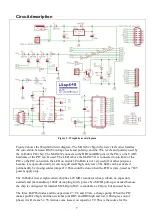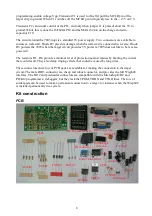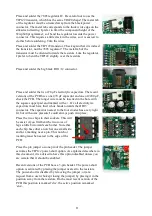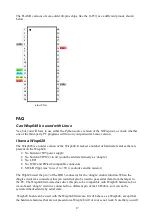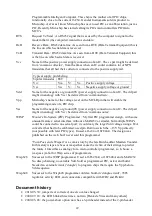
21
Abbreviations and acronyms
CTS
Clear To Send : An RS232 signal that was used by the modem to indicate to the
connected computer that it could send data. To avoid any waiting by legacy
applications or drivers, it is often connected to the RTS line.
DSR
Data Set Ready : An RS232 signal that was used by the modem to signal that it was
switched on and ready for use. To avoid any waiting by legacy applications or drivers,
it is often connected to the DTR line.
DTR
Request To Send : An RS232 signal that was used by the computer to signal to the
modem that it (the computer) was switched on and ready for use.
GND
GrouND : The neutral and return signal.
ICD2
In-Circuit Debugger 2 : A Microchip programming and debugging tool. It is a bit
expensive, but supports a very wide range of PIC chips. When you switch target PIC
chips very often it can be a bit annoying that it needs to download new firmware when
you switch to a different target PIC type. A PICkit2 has both USB and serial
connectors. It can use an external power supply (wall wart), it can draw power from
the USB bus, or it can be powered from the target circuit. When powered from a wall
wart the ICD2 can vary the target Vdd voltage.
LVP
Low Voltage Programming : Using its PGM pin to switch a target PIC chip to
programming mode.
HVP
High Voltage Programming : Using a high voltage its MCLR pin to switch a target
PIC chip to programming mode. This high voltage (see Vpp) is needed only to enable
the programming mode, it does not supply any significant current.
MCLR
Master CLear and Reset : The reset pin available on most PIC chips. This pin also
serves to enable the PIC programming mode, when the pin is (quickly) raised from 0V
to the Vpp level. On most PIC types the Vpp level is ~ 13V.
PICkit2
A Microchip programming and debugging tool. Much cheaper than an ICD2, but USB
only, a more limited range of supported target PIC types (especially when used as
debugger), and it can not use a wall wart. But it is a lovely small gadget, and it might
one day support standalone programming.
PCB
Printed Circuit Board
PGC
ProGram Clock : PGC and PGD are the programming interface pins of PIC
microcontroller chips. When the target chip is in programming mode (see Vpp and
PGM) the PGC line is used by the programmer as clock line to shift data bits into or
out of the target chip. The protocol is documented in the “Programming
Specifications” document for the particular chip.
PGD
ProGram Data : see PGC.
PGM
ProGraM : PIC pin that can be configured (in the fuses word(s)) to act as a logic-level
programming enable pin (sampled once when the chip leaves reset). The advantage of
using the PGM pin (LVP) over the use of MCLR as programming enable (HVP) is
that no separate high voltage (see Vpp) is needed. Disadvantage is that the PGM pin is
no longer available as normal I/O pin. Not all PICs have a PGM pin.
On some PICs a floating or high PGM pin can hinder HVP programming. This can be
solved by pulling the PGM pin low. This can be done by a simple pull-down resistor
in the target circuit. Alternately the Wisp648 has a dedicated line (white wire) that is
pulled low at the appropriate moments.
PIC
General Instruments once produced a chip called the PIC1650, described as a

